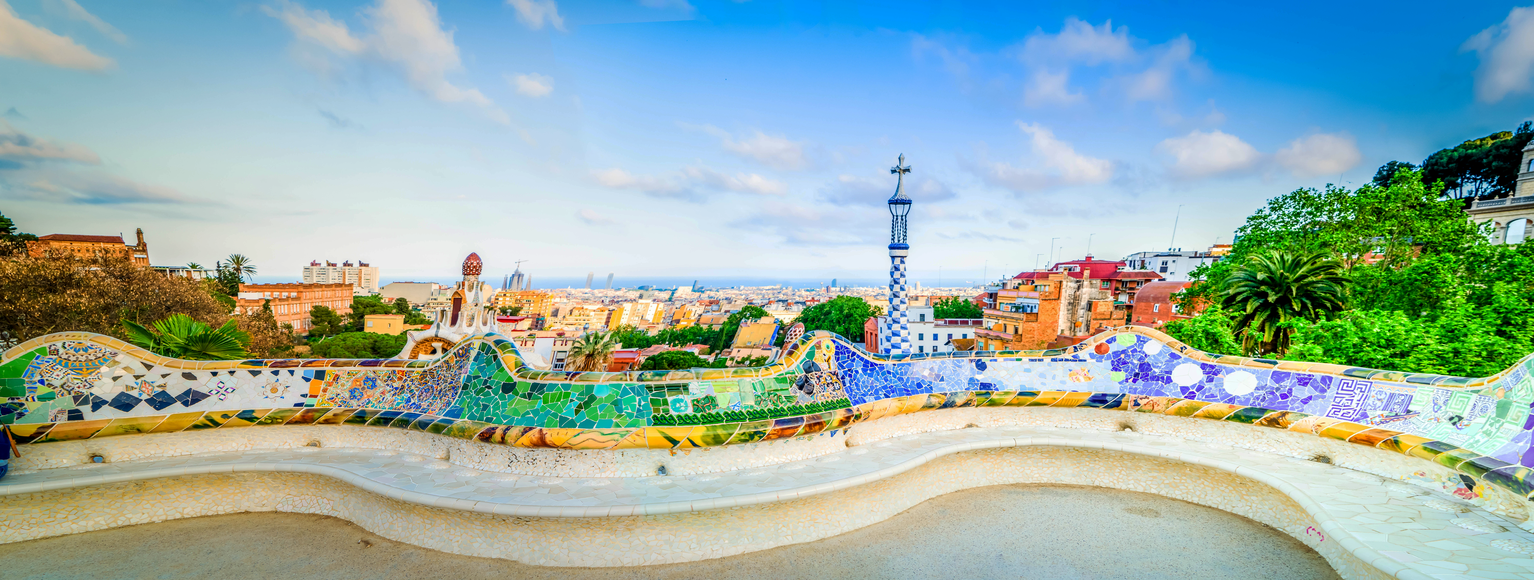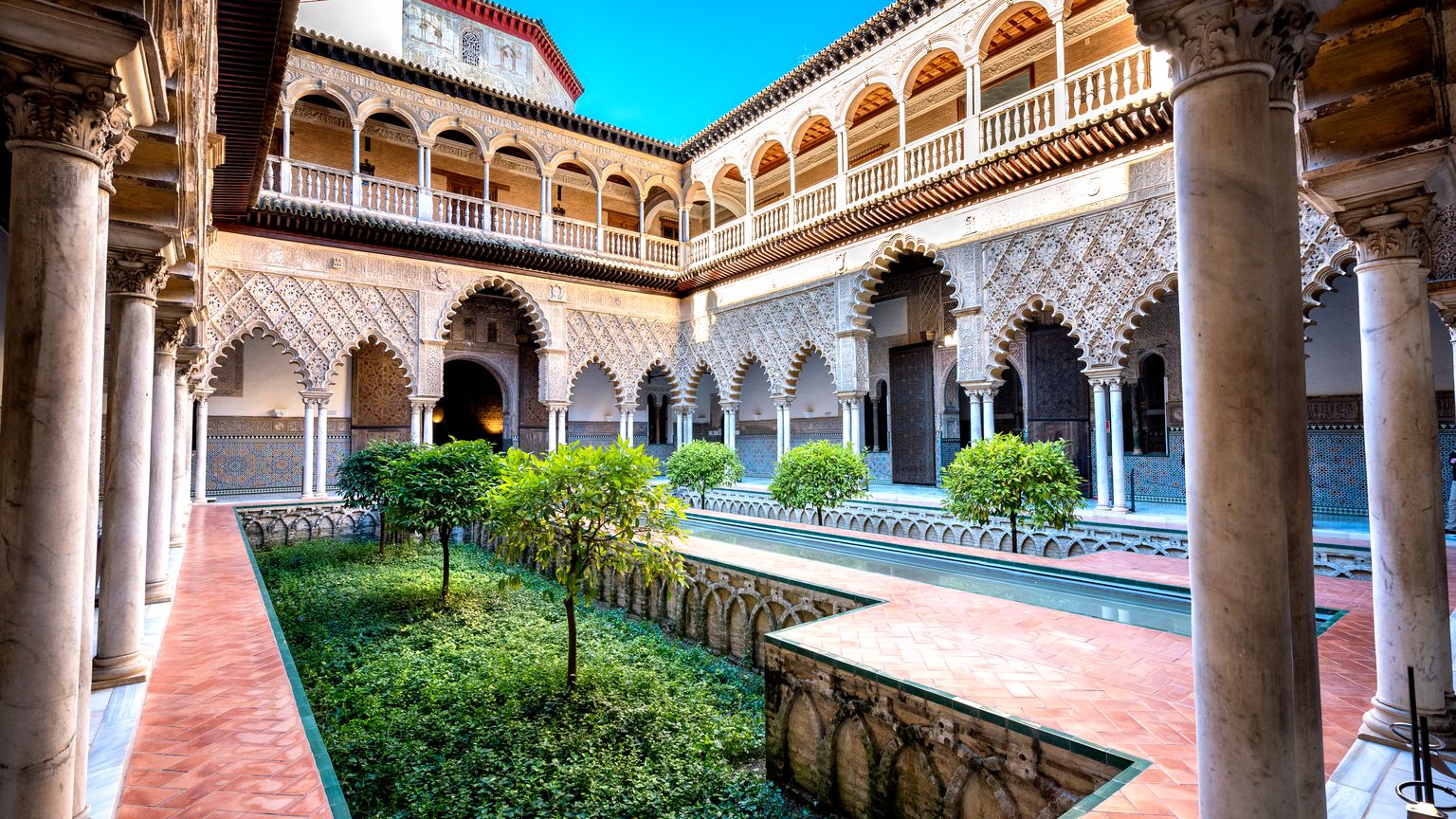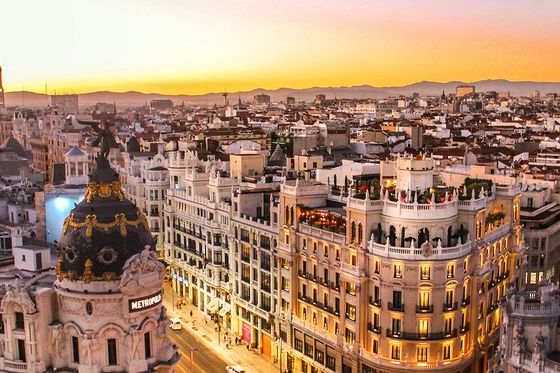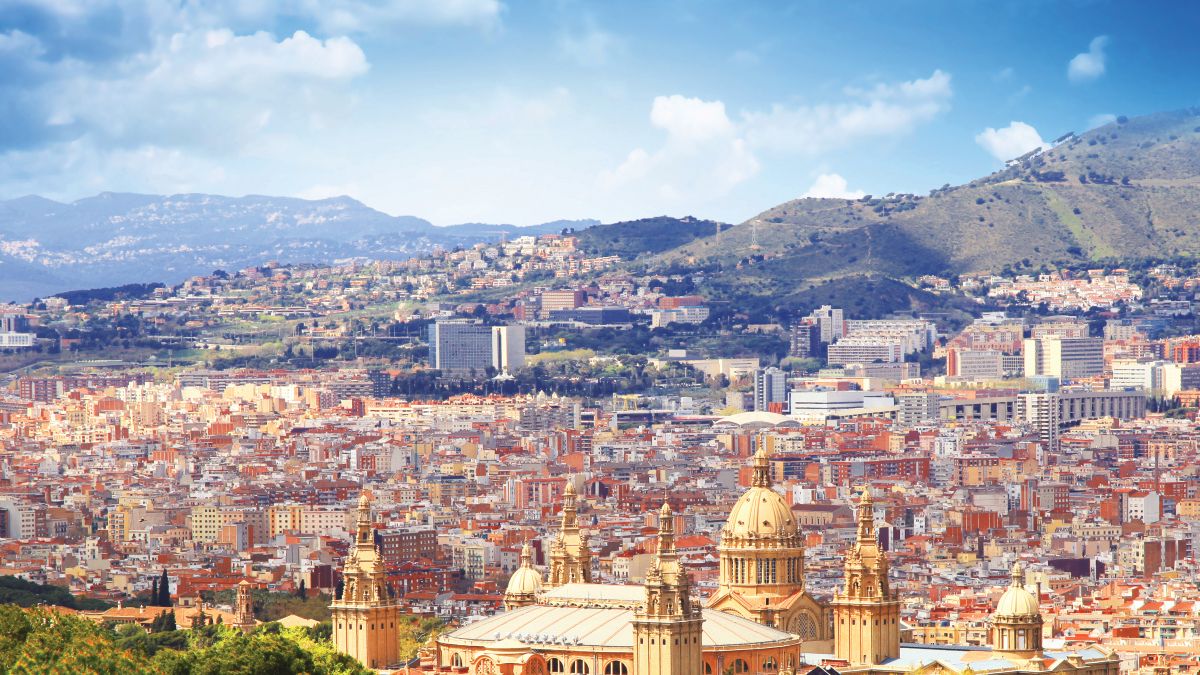
What is Spain known for? From food to flamenco, here are 8 things to love
Spain is a melting pot of cultures, with stunning architecture, beautiful coastlines, impressive art, and tasty cuisine. Here are some of our experts’ favorite reasons to visit Spain.
From the bustling capital city of Madrid to laid-back Barcelona and its time-trapped Gothic Quarter, there’s truly something for everyone in this stunning country—historic palaces, lively food markets, flamenco rhythms, and sun-soaked coastlines. If you’re wondering, “What is Spain known for?” here are eight things to look forward to on your tour of Spain.

1. Architecture
One of the most interesting things about Spain is its architecture, which varies drastically from place to place. Take Seville’s Plaza de Espana, a marvel of Spanish Renaissance and Moorish Revival covered with more than 7,000 colorful ceramic tiles. Or more modern works, like Frank Gehry’s silver, sculptural Guggenheim Bilbao Museum—a highlight on our 12-day Northern Spain: Basque Country to Madrid tour.
Here are a few other well-known, artfully designed sites worth seeking out.
The Alhambra
Perched above Granada, the Alhambra is one of Spain’s most iconic landmarks. This fortress was the Moorish sultans’ last stronghold in Spain. You can admire intricate tiles, stucco work, geometric patterns, and ornate vaulted ceilings that preserve Spain’s layered past. Wander through arched courtyards with bubbling fountains and stroll through serene gardens of roses, myrtle, and orange trees that perfume the air year-round.
Insider tip: The best time to take in the Alhambra’s grand complex is during the cooler months of fall and spring. Visit on our Off-Peak Spain: Madrid, Granada & Seville tour to fully embrace your visit.
The Royal Alcazar
This ancient, UNESCO-protected building in Seville is the oldest royal palace in use in Europe, with centuries of design layered into every arch and alcove. The Royal Alcazar showcases Mudejar architecture—where Islamic artistry meets Christian grandeur. Ornate stucco walls, coffered wooden ceilings, and patterned tiles unfold in room after room. From its sun-dappled courtyards to its lush, palm-lined gardens, this royal residence feels like a dream etched in stone.
The Mezquita
Step inside Cordoba’s Mezquita and you’ll find yourself in a forest of red-and-white arches—an awe-inspiring blend of cultures under one soaring roof. Originally built as a mosque in the 8th century and later transformed into a cathedral during the Reconquista, this architectural marvel is a testament to Andalusia’s layered history. Its serene symmetry, intricate mosaics, and juxtaposition of a central Christian altar and a Mecca-facing mihrab create a space that’s both sacred and spellbinding. Visit on our Off-Peak Spain: Madrid, Granada & Seville tour for a more exclusive feel without summer’s crowds.
The Sagrada Familia
Catalan Modernist architect Antoni Gaudí’s awe-inspiring Sagrada Familia is equal parts cathedral and sculpture that blends Gothic grandeur with natural forms. More than a century later, it’s still under construction—a testament to patience, devotion, and the kind of beauty that’s always becoming. On our Grand Tour of Spain, you can step inside to marvel at the intricate details and the kaleidoscope of colors pouring in from the stained glass windows.
Insider tip: Barcelona is peppered with so many of Gaudí’s impressive works that it’s basically a large outdoor museum. In addition to the Sagrada Familia, you can check out Park Guell, Guell Palace, Casa Batllo, Casa Mila, and Casa Vicens on a stroll through the city in your free time. It’s a free (and fun!) way to see the stunning exteriors of some of the top places to visit in Spain.
“If you love architecture, Barcelona will not disappoint!” said first-time traveler Felicia after our A Week in Spain: Barcelona, Madrid & Seville tour. “I absolutely enjoyed visiting Gaudí's work! Highly recommend visiting Casa Batllo!”

2. Legendary art
Spain’s art scene is a masterpiece in itself—layered, bold, and rich with expression. From classical to contemporary, the country’s world-class museums house the stories, symbols, and strokes that shaped Spanish culture and influenced the world. Whether you’re drawn to Renaissance grandeur, modernist rebellion, or cutting-edge installations, Spain’s top museums offer a journey through the evolution of art.
Here are a few of the world-class museums Spain is known for.
The Prado Museum
The Prado is Spain’s crown jewel of classical art. Inside Madrid’s elegant museum, you’ll find a treasure trove of European masterpieces—from Diego Velázquez’s “Las Meninas” to Francisco Goya’s Black Paintings, including the haunting “Saturn Devouring His Son.” With works spanning the 12th to the early 20th century, the Prado captures the soul of Spanish history through its most iconic artists.
The Reina Sofia
Just a short stroll from the Prado, the Reina Sofia brings Spain’s modern era into focus. Its piece de resistance? Pablo Picasso’s “Guernica”—a powerful anti-war statement that still echoes today. The museum also houses works by Salvador Dalí, Joan Miró, and other 20th-century pioneers of Spain’s most provocative and visionary decades.
The Guggenheim
Gleaming titanium curves and a picturesque riverside perch make the Guggenheim Bilbao as much a work of art as what’s inside. This modern marvel reshaped the city and redefined how we experience contemporary art. Step inside for bold installations, boundary-pushing exhibits, and a space that celebrates innovation in every form.

3. Flamenco, the soul of Spain
On our 11-day Journey through Andalusia: Seville, Granada & Malaga tour, you’ll discover one of the region’s most unique and colorful art forms: flamenco. More than a dance, the UNESCO-listed artistic expression combines expressive singing, moving instrumentals, and passionate dancing with southern Spanish traditions.
Storytelling and cultural significance
Born in the heart of Andalusia, flamenco weaves together centuries of influence from Romani, Moorish, Jewish, and Andalusian cultures. Through haunting guitar melodies, percussive footwork, and impassioned vocals, flamenco tells stories of love, loss, resistance, and resilience. When intense emotion takes hold of the performers and they create a vulnerable, spiritual-like shared moment with the audience, it’s known as “duende.” Flamenco becomes more than art when duende is present—it becomes a visceral, transcendent experience.
Where to experience it live
You can feel the duende firsthand on any of our Seville tours. Or, if you’re wanting to travel beyond Spain on one trip, we offer a unique Granda Flamenco Show excursion within a cave on our Portugal, Spain & Morocco tour. We also attend flameno performances on several of our Madrid tours.
“I still think about the amazing flamenco performance I saw on the Madrid Flamenco Show excursion on our Food & Wine: A Taste of Spain tour,” said staffer Jamie. “To this day, it’s one of the most beautiful, captivating things I’ve seen. There was so much emotion in the performers’ song and dance. The show actually brought me to tears! Everybody who goes to Spain should have this on their bucket list, truly.”

4. Food markets and culinary experiences
One of the best ways to understand a country’s culture is through its markets, and this is especially true in Spain.
Here are some of our favorite markets to sample the local flavors.
Mercado San Miguel
In Madrid, the Mercado de San Miguel is a great spot for solo travelers to mingle with people at different stalls and sample a variety of tapas. “My favorite part of Spain was trying all kinds of foods and meeting all kinds of people at the incredible markets,” said staffer Lauren. “Every city in Spain has one, and they’re all perfect in their own way. If you’re ever in Spain, try to go to at least one. You’ll thank me later.”
Explore Spain’s market of San Miguel with our insider tips →
Mercado San Martin
San Sebastian is one of the premier foodie destinations in Spain, and pintxo-hopping from bar to bar is a cultural pastime. In fact, it's one of the six things we thing should top your Spain bucket list. It’s also a great way to explore the city and taste different flavors without filling up on one big dish. The Mercado San Martin is a great one-stop-shop to taste it all as you make your way from stall to stall. Or, if you’d prefer to see the city as you snack on these bite-sized delights, opt for the San Sebastian Pintxos Walking Tour excursion on our France & Spain: Paris, Bordeaux & Madrid tour.
Mercado Boqueria
While each market is memorable, La Boqueria in Barcelona—which you can access from La Rambla, Barcelona’s famous tree-lined pedestrian boulevard—is a classic stop that staffer Steph loved exploring during free time on our nine-day A Week in Spain: Barcelona, Madrid & Sevilla tour. “This indoor market is wonderfully hectic and the perfect spot to pick up any sort of produce, meat, or prepared food if you’re hungry and looking for a snack to fuel a day of sightseeing,” she said.

5. Spanish food and wine
Speaking of food, Spain’s cuisine is world-famous, as is its wine (this is the land of Cava, after all!). Check out our 12-day Food & Wine: A Taste of Spain tour to really sink your teeth into the culinary scene. In San Sebastian, get ready to sip Basque Country cider and slightly effervescent white wine called Txakoli, You’ll sample marmitako, a tuna stew once eaten on fishing boats in the Cantabrian Sea. “In Spain, I ate and drank very well,” said first-time traveler Kristen. “Given the chance, I would gladly repeat the whole tour again just to enjoy Spanish hospitality, food, and wine.”
If you’re wondering what Spain is famous for in terms of cuisine, here are some other favorites.
Tapas and regional dishes
- Paella: Originally from Valencia, this classic dish combines rice, saffron, vegetables, and typically chicken and seafood, all cooked together and served in one pan. Traditionally, it was enjoyed straight out of the pan with wooden spoons.
- Tapas: This isn’t just one food, but a variety of small, savory dishes, like Spanish tortilla, patatas bravas, Iberian ham-topped toast, and croquettes. People eat tapas as shared appetizers, snacks, or even full meals.
- Pintxos (or pinchos): These small, tapas-like bites made of fish, meat, or vegetables atop a piece of bread are typically served in bars in northern Spain, particularly in Basque Country. Their name means “spikes” referencing the toothpick that holds them together.
- Churros: This Spanish pastry hits the sweet spot between donuts and choux pastry. These long, sugar-doused sticks of fried dough are even more delicious when dipped in thick, melted chocolate.
Spanish wines and cava
Rioja: Spain’s most famous red wine hails from the La Rioja region. Often made from tempranillo grapes, it’s known for rich, oaky flavors and pairs beautifully with cured meats and manchego cheese.
Ribera del Duero: This bold, full-bodied red comes from northern Spain and is beloved for its deep color, dark fruit flavors, and aging potential. It’s a favorite among wine lovers looking for something robust.
Albarino: Grown in the misty Rias Baixas region of Galicia, this crisp, aromatic white wine is known for its citrusy zing and light body—perfect for sipping seaside with seafood.
Cava: Spain’s sparkling answer to Champagne, Cava is dry, refreshing, and just the thing to toast with on a sunny afternoon or a lively night out.
Sherry: Locally called Jerez, this fortified wine from Andalusia ranges from dry to decadently sweet. Often misunderstood, true sherry is a complex, nutty drink that plays well with salty tapas and aged cheeses.

6. Sun-soaked beaches and islands
Mainland Spain is surrounded by the Mediterranean, Cantabrian Sea, and Atlantic Ocean. The country is also home to two archipelagos: the Balearic Islands, situated off the coast between Valencia and Barcelona, and the Canary Islands, which are southwest near Morocco. When travelers ask, “What is Spain known for?” beaches is one of the top answers. The country’s sandy shorelines are some of the best in Europe—and are located right near city centers like Barcelona and San Sebastian.
Costa del Sol and Spain’s mainland beaches
Spain’s mainland beaches—especially along the famed Costa del Sol—offer more than just sun and sand (though there’s plenty of both). With over 300 days of sunshine a year, this southern coastline lives up to its name, which translates to “Coast of the Sun.” Picture golden beaches backed by whitewashed villages, tapas bars just steps from the water, and a Mediterranean breeze that makes even the hottest days feel just right. Whether you’re wandering along Marbella’s chic promenades, swimming off Nerja’s hidden coves, or savoring seafood in Malaga, the Costa del Sol combines Andalusian charm with effortless seaside living.
Balearic Islands of Menorca and Mallorca
The Balearic Islands bring a slower, sun-soaked rhythm to Mediterranean life. Menorca is known for its quiet coves, turquoise waters, and a relaxed pace of life, while Mallorca blends dramatic mountain landscapes with charming villages and postcard-worthy beaches. Both islands offer the perfect mix of nature, local culture, and coastal bliss.
Our 10-day Spain’s Balearic Islands: Menorca & Mallorca tour explores some of the country’s off-the-beaten-path beaches and coastal villages that third-time traveler Brianna called “a perfect mix of city and island paradise.” She added: “Would highly recommend this tour if someone wants to experience the islands in a way beyond sitting on the beach. The history and experiences we were able to enjoy on this tour were fabulous. We did many things that I probably never would have done or known to do had it not been for Go Ahead’s organization and guidance.”
)
7. Sports and passionate pastimes
Spain’s culture is as lively and layered as its landscapes, with traditions that stir both passion and pride. From the roar of futbol fans to the centuries-old Spanish traditions, these experiences offer a glimpse into the soul of the country—whether you’re cheering in the streets or reflecting on evolving customs.
Soccer (aka futbol) culture
Football (what we know as soccer) is a huge part of Spanish culture. Spain has some of the biggest club teams, like Real Madrid and FC Barcelona, and a very talented FIFA national team. Stop by any bar or cafe while a game is going on and let the sport and excitement entrance you.
“I don’t even like sports, and I couldn’t help but feel invested while I watched the game and cheered with the rest of the crowd,” said staffer Lauren. If you’re visiting during an important game, join the crowds gathering in front of giant screens in city centers or around Real Madrid’s stadium, Santiago Bernabeu. The main phrase to know: “¡A por ellos, oe!” Translation: Let’s beat them!
Bullfighting perspectives
Bullfighting has long been woven into the cultural and historical fabric of Spain, tracing back centuries as a symbol of bravery, artistry, and ritual. Once seen as a display of honor and skill, it has inspired countless works of literature, music, and art. However, in modern times, bullfighting has become a subject of debate—many Spaniards and international visitors now view it as a controversial tradition, raising ethical concerns about animal welfare. While still practiced in parts of the country, public opinion continues to shift, and some regions have moved to ban or limit the spectacle altogether. We do not include bullfights on any of our itineraries because it does not align with our animal welfare practices.

8. The warm, welcoming people
Spain is known for its welcoming culture, where hospitality is a way of life. Whether you’re sharing tapas with locals, getting travel tips from a shop owner, or joining in on a village festival, there’s an open-armed spirit that makes visitors feel like part of the family. It’s this easygoing, joyful vibe that turns a trip to Spain into something unforgettable.
Each part of the country is bursting with its own unique identity and flavors, and enthusiastic locals who are eager to share their traditions. From Andalusia’s cured ham and Moorish architecture to Basque Country’s skewered pintxos and iconic surf spots to the stunning beauty of Spain’s Balearic Islands, Spaniards are exceptionally proud of their country’s beauty.

Discover your own Spain
Whether you’re drawn by Spain’s awe-inspiring architecture, rich artistic legacy, flavorful cuisine, or warm and welcoming culture, there’s something here for every traveler to fall in love with. Join us on a Spain tour to explore this vibrant country from every angle.
Deep dive into Spain’s culture, from Madrid to the Mediterranean on our Grand Tour of Spain, where the charismatic locals and cosmopolitan cities shine. Or uncover a quieter side of Spain on our Off-Peak Spain: Madrid, Granada & Seville tour and savor Spain the way it’s meant to be—deliberately, delightfully, and without the press of crowds. Let us handle the details so you can focus on soaking up the spirit of Spain one unforgettable moment at a time.
































































































